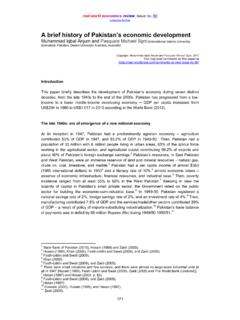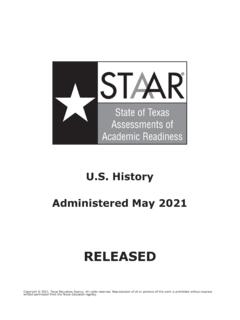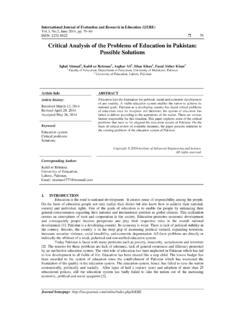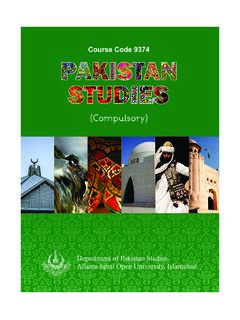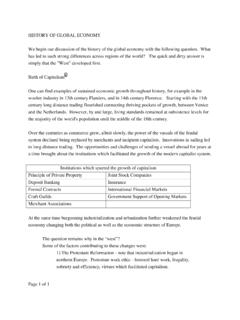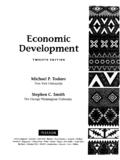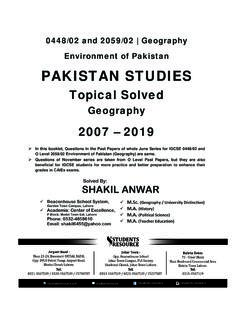Transcription of Educational Disparity in East and West Pakistan, 1947-71 ...
1 The Bangladesh development Studies Vol. XXXIII, September 2010, Educational Disparity in East and West pakistan , 1947-71 : Was East pakistan Discriminated Against? MOHAMMAD NIAZ ASADULLAH* This paper documents the regional divide in Educational facilities between East pakistan (now Bangladesh) and West pakistan between 1947 and 1971. During this period, the total number of primary schools in East pakistan declined, leading to overcrowding of existing schools and classrooms. On the other hand, despite being endowed with fewer schools, West pakistan surpassed East pakistan in the total number of primary schools, and in teacher-student ratios.
2 This evident Educational Disparity , we argue, cannot be attributed to regional differences in school age population, school types, the quality and unit cost of schooling. Rather, this problem is examined in terms of the hypothesis of discrimination as an alternate explanation. I. INTRODUCTION pakistan emerged as an independent nation in 1947 breaking apart from India on the basis of a two-nation The Muslim majority province of East Bengal (subsequently East pakistan ) joined Punjab, North-West Frontier Province, Sind and Baluchistan to form the undivided However, after a quarter-century of union with West pakistan , the Eastern part of pakistan broke away in 1971 *Department of Economics, University of Reading, UK; ESRC Centre on SKOPE, Department of Education, Oxford University.
3 Institute for the Study of Labour (IZA), Bonn, Germany. 1I would like to thank Bob Allen, Geeta Kingdon, Avner Offer, Bettina Robotka, and an anonymous referee for their comments and suggestions. An earlier version of the paper was presented at Nuffield College (Oxford), the 17th Conference of the International Association of Historians of Asia (IAHA), economic history Association Meeting (Nashville), and the economic history Society (EHS) Conference 2004 (Royal Holloway, University of London). 2 These latter four provinces altogether comprised West pakistan , being separated from the East by 1100 miles of Indian territory.
4 The Bangladesh development Studies 22following a year long civil war. economic maltreatment of East Bengal, it is argued, was one of the factors that led to the disintegration of pakistan in 1971 leading to the creation of Bangladesh (Auspitz et al. 1971, Islam 1972, Rao 1972, Laporte 1975, Bhatia 1979). Discriminatory allocation of government budget across provinces arguably led to big disparities in the development of infrastructure facilities which, in turn, resulted in marked disparities in economic welfare. If true, similar inequalities would have affected the social sectors. For instance, the supply of schools might have been constrained as a consequence of tightened public budget, directly affecting Educational A regional divide in Educational quality could also ensue.
5 Given allegations of negative bias in economic policy towards East Bengal, a comparative study of the distribution of Educational resources and outcomes during the 24 years of united pakistan is a natural line of inquiry. While the past literature has focused on the question of economic Disparity , relatively little is known about inequalities that existed between the two regions in other spheres such as education. Earlier studies, Curle (1966), while suggestive of disparities in the distribution of Educational inputs in the two wings, do not provide a detailed account of the Educational facilities and their evolution during 1947-71 .
6 In addition, none of the early researchers systematically examined the causes behind such inter-regional Disparity . Recent research ( Khatun 1991, Ahmad 1999) on the issue provides only a snap-shot of the situation, conveniently attributing the observed Disparity to discrimination by the state. However, sources of Disparity may simply lie in unaccounted differences in, say, demographic and socio- economic characteristics of the population, structure of the education sector in the comparing regions and so on. Little is known about any differences in these factors that may mirror inter-regional differences in Educational facilities.
7 To the best of our knowledge, none of the past research on regional Disparity ( Curle 1966, Huq 1968) or contemporary studies on education in pakistan ( Iqbal 1993, Kazi 1994, Hoodbhoy 1998) has looked into these issues in detail. The objective of this study is to examine whether there existed systematic bias in the distribution of Educational resources and facilities during 1947-1971 between East and West pakistan . We accomplish this by quantifying the extent of inter-regional Educational Disparity and its evolution over time. Our analysis reveals a decline in Educational facilities, both in terms of the relative and absolute availability of primary schools, in East pakistan .
8 Collating dis-aggregated regional 3 Total school enrolment (or coverage) tends to increase with GDP level. Hence, if the rate of economic growth is smaller than that of the school age population, Educational expansion is constrained by resource availability. Asadullah: Educational Disparity in East and West pakistan 33data on school types, quality, unit cost of school, and public expenditure on education, we further describe the causes behind inter-regional differences in the education sector in pakistan . It is argued that the decline in primary school availability in East pakistan was largely an unintended consequence of a resource constraint that arose in the backdrop of biased inter-provincial transfer of resources.
9 By comparing East pakistan with selected Indian states, we provide a crude test for the above claim in a quasi-natural experiment framework. Comparison of Bangladesh and pakistan before and after 1971 yields a further test of the hypothesis of resource crunch, yet again mimicking a natural experiment. The next section describes the broader political context in which resources were allocated across regions in pakistan during 1947-71 . Section III provides an overview of Educational planning in the country, in addition to describing the Educational profiles of East and West pakistan . The inter-regional differences in Educational facilities during the said period are discussed in section IV.
10 Section V considers various potential explanations for inter-regional differences in education between East and West pakistan and advances the hypothesis of resource constraint as a residual explanation. Two simple tests of this hypothesis are elaborated in section VI. Section VII is conclusion. II. BACKGROUND: economic POLICY MAKING IN pakistan Following its separation from India, pakistan inherited a federal structure of governance under which subjects such as foreign affairs, defence and commerce were administered by the central government whilst matters like education and health were concerns of the respective provincial governments.

